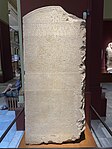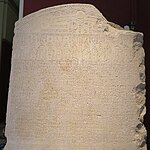Decree of Canopus
| Decree of Canopus | |
|---|---|
 | |
| Material | Granodiorite |
| Size | 7 feet 4 inches in height |
| Writing | Egyptian hieroglyphs, demotic, and Koine Greek script |
| Created | 238 BC |
| Discovered | 1866 Tanis, Egypt |
| Discovered by | Karl Richard Lepsius |
| Present location | Egyptian Museum, Cairo, Egypt |
The Decree of Canopus is a trilingual inscription in three scripts, which dates from the
Ancient Copies of the Decree
In 1866, Karl Richard Lepsius discovered at Tanis the first copy of this Decree (this copy was originally known as the 'Şân Stele'). Another copy was found in 1881 by Gaston Maspero at Kom el-Hisn in the western Nile Delta. Later on, some other fragmentary copies were found.
In March 2004, while excavating at Bubastis, the German-Egyptian 'Tell Basta Project' archaeologists discovered yet another well preserved copy of the Decree.[2]
Importance for the decipherment of hieroglyphs
This is the second earliest of the series of
- The Decree of Alexandria from 243 BC;
- The Decree of Canopus of Ptolemy III in 238 BC;
- The Ptolemy IVin 218 BC;
- The Ptolemy Vin 196 BC.
Contents of the inscription
The inscription touches on subjects such as military campaigns, famine relief, Egyptian religion and governmental organization in
The Decree of Canopus attested the existence of the ancient city of
Calendar reform
The civil
This Ptolemaic calendar reform failed, but was finally officially implemented in Egypt by
Gallery
-
the Decree of Canopus, on display at the Egyptian Museum in Cairo, Egypt
-
top portion of the Decree of Canopus, on display at the Egyptian Museum in Cairo, Egypt
-
middle portion of the Decree of Canopus, on display at the Egyptian Museum in Cairo, Egypt
-
bottom portion of the Decree of Canopus, on display at the Egyptian Museum in Cairo, Egypt
See also
- Ptolemaic Decrees
- Ptolemy IV
- Ptolemy II
- Ptolemy V
References
- ISBN 1-4021-7101-3, p. 295
- ^ Tietze, Christian; Lange, Eva R.; Hallof, Klaus (2005). "Ein neues Exemplar des Kanopus-Dekrets aus Bubastis." Archiv für Papyrusforschung und verwandte Gebiete 51, 1, pp. 1–29.
- ^ "Egyptian Texts: Canopus Decree". attalus.org. Retrieved 2023-04-27.
- ^ PDF file Research by Franck Goddio
- ^ "Egyptian to Julian conversion: Canopic reform analysis". www.instonebrewer.com. Retrieved 2023-04-27.
- ^ Pfeiffer 2015, pp. 79–80 and 85–86.
- ISBN 0-87169-214-7, p. 47
- ^ Chris Bennett, Egyptian Civil Calendar and table note 372
Sources
- Budge. The Rosetta Stone, ISBN 0-486-26163-8)
- Pfeiffer, Stefan. Das Dekret von Kanopos (238 v. Chr.). Kommentar und historische Auswertung eines dreisprachigen Synodaldekretes der ägyptischen Priester zu Ehren Ptolemaios' III. und seiner Familie. Munich/Leipzig: K. G. Saur, 2004.
- Pfeiffer, Stefan (2015). Griechische und lateinische Inschriften zum Ptolemäerreich und zur römischen Provinz Aegyptus. Lit. pp. 75–88. ISBN 978-3-643-13096-9.
External links
- The Canopus Decree, Hieroglyphic version: full translation by E. A. Wallis Budge (about 1800 words; copied at attalus.org )
- The Canopus Decree, Greek version: full translation at attalus.org )
- Stele of Canopus and the Rosetta Stone




